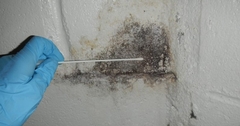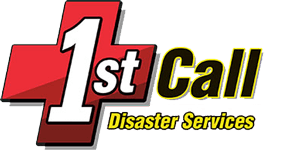Blog Post
All About Mold Series – #6 What Happens and What to Expect During a Mold Inspection

Do you think mold might be present in your home? If so, continue reading to learn more about the signs of mold and when one should have a mold inspection performed OR when one can simply exercise common sense by cleaning and drying properly.
Goals of a Mold Inspection
- Main goal is to locate a reason for elevated moisture levels that are encouraging mold colonies to propagate.
- A secondary goal is to capture the spores and remove the problem growth from the structure.
Why You Should Have a Mold Inspection – SAVE MONEY
Even if one has already found mold growing in the home, an inspection seeks to determine, by virtue of data collection, whether or not professional remediation services are warranted or whether the issue can easily be remedied with laymen's solutions suggested by the professional. Many times, remediation is putting the proverbial "cart before the horse", by virtue of not properly addressing moisture intrusion issues FIRST. It is a waste of hard-earned money to do so! A small inspection fee can potentially SAVE thousands by providing intelligent data.
Signs of Mold
- Common allergy-like symptoms persist
- Odors are chronic that are akin to stale water, rotting wood, organic deterioration, etc (people will often say they "smell mold")
- Known water intrusion issues that have NOT professionally addressed
Hiring a Professional Mold Inspector
Is is ALWAYS a good idea to hire a professional to perform a mold inspection? Is is better stated this way: "A professional that has experience remediating mold properly has the potential to SAVE MONEY." The associated fee is a small risk that can potentially save time, money and unnecessary alarm.
Consider an inspection a laser approach – it removes guesswork and uneducated remediation practices. MANY times, full blown remediation services are not necessary!
Moisture meters, probes and infrared instruments have the opportunity to provide a mixture of non-invasive and invasive measures for dealing with mold issues that are serious in nature. At some point, it MAY become necessary to involve an Indoor Environmental Professional (IEP). An initial inspection can determine the level of involvement needed. Involving an IEP would be akin to moving from a laser pointer to a laser that can cut diamonds. Even though some costs are associated the data produced by the IEP continues to narrow the focus of the remediation efforts.
History of Water Problems
When performing an inspection, a professional SHOULD ask you about past issues with water intrusion/damage, etc. It is crucial information to determining what is next and where to begin searching. Please tell them about any leaks, floods or other moisture problems that have been present in the past. Regarding a self-inspection: concentrate on areas which have had known water problems. Look for signs of moisture damage such as warped surfaces, peeling paint or water stains as this could narrow the search of where mold is most likely to grow. Be aware of other areas that have the potential for water problems such as air conditioner leaks, leaking roofs or areas where water or condensation collect.
MYTH BUSTER: While municipal or government agencies have condemned properties in the past, it is a VERY EXCEPTIONAL practice and is typically associated with vacant homes, neglected individuals living in homes without persons caring for them and are extreme in nature. Disclosing information regarding water losses or known maintenance issues does not constitute condemnation of a property – doing so openly is a prudent and honest activity that fosters careful maintenance. "ET" was a movie. Mold remediation normally does not require a home/business to be wrapped like a ziplock bag and armed guards brandishing an AR-15 at the ready.
Finding Mold
DISCLAIMER: mold is everywhere, everyday and it cannot be escaped by human beings. The question is this: is it causing a problem and is it growing and appearing abnormally.
Pay special attention to areas around water sources: near the shower, tub, under sinks and around pipes. Keep them clean and dry to avoid issues. Carefully check the areas which have had a history of moisture problems in the past. If water leaks are found and not properly dried and treated, mold growth will occur at some point. Other common areas to find mold are ventilation ducts, under carpets, drywall and insulation and under sinks/cabinets.
Hidden Mold
See section above's disclaimer: there are really only two types of mold – seen and unseen. When it becomes visible in a structure and persist – it IS a problem and needs to be addressed with professional, qualified care and procedure. IF physical symptoms or large amounts of mold exist, then it is likely an event that justifies dealing with the unseen by obtaining an air-quality test. The initial inspector will be able to assist property owner's with this process.
Pay attention and be cognizant of any odors during the search. The nose is a valuable tool for discovery. In fact the nose – an indicator of allergies associated with mold, may tip on off far sooner than the odorous aspects.
Don't Disturb Mold
Large mold colonies should only be disturbed once a professional has been consulted. Call for assistance with this level of involvement. Reputable professionals will often teach, coach and pre-qualify immediate steps prior to wasting valuable dollars on unnecessary inspections and remedies. However, it is prudent to avoid disturbance until a professional has been consulted.
Acknowledging What Mold Leaves Behind
Very quickly – mold is a living organism and ALL living organisms produce waste. Many misconstrue staining left behind following mold remediation as an issue. This is largely untrue as it is simply that – a stain. Rarely any different that stain left behind by a plant that was watered too much on a wooden substrate. Yes, there are times when a deeper treatment is warranted for semi-porous materials but the practice of removing stained material is typically a practice observed in the early years of dealing with mold related problems. For a cosmetic or aesthetically pleasing surface a sealant can be applied OR is applied for preventative measure. There are times when this is specifically called out in a protocol issued by and IEP but it is most often a suggestion or desired look rather than a mandate.
Finding Water Problems
In conjunction with finding the colonized growth it is imperative to locate the water problem that likely caused the mold to begin with. It is pointless to find and remove the mold from the home/business if the water problem that caused it is not repaired to prevent future mold growth. "Don't waste your money" as many will say. Typically, the professional addressing the mold, should be able to direct these efforts as well. If not, please contact 1st Call Disaster Services for needed assistance with "next steps".
Mold Testing
As stated in this and other articles posted by 1st Call Disaster Services – knowing what species of mold one is dealing with CAN be very important for medical reasons. However, it is most often more important to capture whatever species are present and remove them. In any given air sample, there can be 30-70+ species of mold present. Which one is the real trouble-maker can only be determined by medical professionals. Are there molds that are more prone to cause health issues? YES. Generally speaking, "the big three" for our area that have a nasty reputation are: penicillium, aspergillum and stachybotrys (toxic in nature and largely and indicator of long-term moisture issues). Again, the ultimate goal is not to kill mold but rather to capture it and prevent it from causing further issues.
Mold Remediation
Once it has been determined that the volume of mold in the home/business are at levels unacceptable for healthy air-quality levels, the mold removal and remediation process can begin in earnest.
There exists points whereby professional remediation is called for either by an IEP OR by published best practices/standards outlined by the EPA or other health related entities. In these instances degrees of severity are analyzed by the number of square feet of mold present or poor air-quality results . As the amount of square feet incrementally increase so do the amount of engineered controls associated with said levels of contamination/remediation.
HOWEVER, the home/business owner can have ANY amount of mold removed exacting any level of control desired – to this degree it becomes a level of comfort or importance that dictates the extent to which engineered controls are placed during the process of removal. PLEASE NOTE: that IF an air-quality test is deem necessary by either the professional OR the property owner this can ONLY be achieved by following a certain degree of process and engineered controls. There are NO shortcuts and there are costs associated with these carefully prescribed steps that will need to be considered.
RESTATED: Any property owner can decide they want what is called a "post remediation evaluation" for ANY level of contamination. Just understand that with each level of desired remediation there is a cost increase associated.
Air-Quality Sampling
Is it ALWAYS necessary? No. Is it ALWAYS prudent? One can never go wrong by subscribing the process to this scrutiny, but is it worth the costs? It is an answer that goes something like this: "it depends"
1st Call Disaster Services specializes in eliminating mold issues and providing preventative measures to address areas of moisture intrusion.
A good restoration company can make sure a mold remediation is done right and that you're out of pocket damage liability is kept to a minimum. We've helped numerous home and business owners and they and their insurance company always appreciate our surgical approach to restoration!
All About Mold Series
- All About Mold Series - #7 When and Why to Test for Mold
- All About Mold Series - #6 What Happens and What to Expect During a Mold Inspection
- All About Mold Series - #5 Signs That You May Have Mold In Your House
- All About Mold Series - #4 A Detailed Look at Mold Remediation
- All About Mold Series - #3 The Health Effects of Mold
- All About Mold Series - #2 Detecting and Removing Mold. Can Mold Make Me Sick?
- All About Mold Series - #1 Understanding How Mold Thrives Can Help Us Prevent Mold Growth In Your Home or Business
